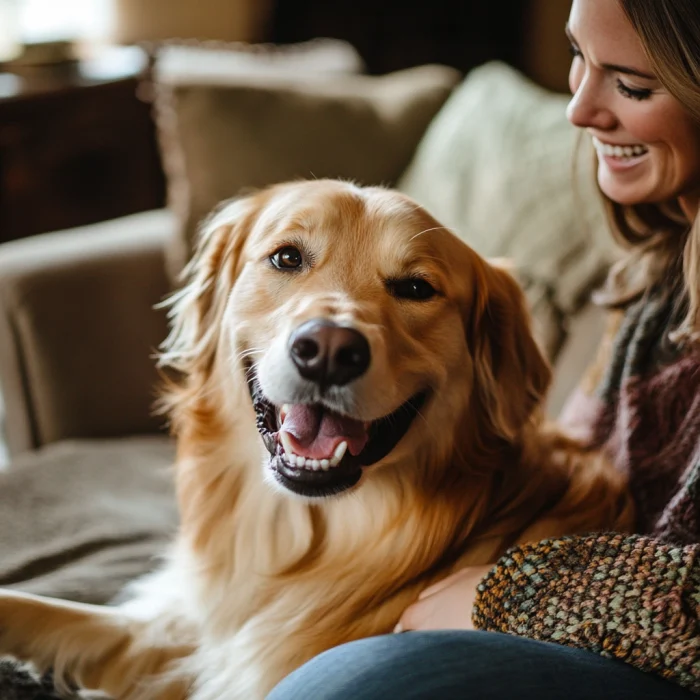Dogs are known for their charming antics, and winking is no exception. Discover why dogs wink, including reasons such as communication, playfulness, or even health concerns. Understanding dog behavior can deepen your bond with your furry friend. Read on to uncover surprising reasons behind your dog’s winks!
Why Do Dogs Wink? The Reasons Might Surprise You
Dogs are highly expressive creatures with a range of behaviors that leave us fascinated. One of the behaviors that many dog owners notice but don’t always understand is when their dog winks. This endearing gesture can seem like a quirky sign of affection, but the truth behind it may be more complex than you think. If you’ve ever caught your dog winking at you, you might have wondered why they do it. Could it be a sign of happiness, health issues, or something else entirely? Let’s dive deep into the reasons why dogs wink and what it might mean.

Table of Contents:
- Why Do Dogs Wink? Understanding the Behavior
- Is Winking a Sign of Affection or Communication?
- The Role of Playfulness in Winking Behavior
- Winking and Social Interaction with Other Dogs
- Health Concerns: Could Winking Indicate a Problem?
- Do All Dogs Wink? Exploring Breed Differences
- How to Interpret a Dog’s Wink Based on Context
- What to Do If You Notice Excessive Winking
- Conclusion: Decoding Your Dog’s Wink
- For More Pet Related Articles Click Here
Why Do Dogs Wink? Understanding the Behavior
Winking is often seen as a playful gesture in humans, but when dogs do it, it can have various meanings. One of the most common reasons dogs wink is as a form of communication. Similar to how dogs use their bodies to communicate (like wagging their tails or posture), winking can also convey a message, depending on the situation. But why do dogs wink specifically? Let’s look at some of the main reasons behind the action.
Is Winking a Sign of Affection or Communication?
One reason your dog might wink is to communicate affection or trust. Dogs often wink as a sign of relaxation and contentment. When a dog feels safe and comfortable with their owner, they may wink to show that they’re not in any distress. Think of it like a human winking at someone as a friendly and affectionate gesture.
It’s important to pay attention to other aspects of your dog’s body language, such as their relaxed body posture, the lack of tension in their face, and their wagging tail. When these signs accompany a wink, it’s a clear indicator that the wink is a gesture of affection or friendly communication.
The Role of Playfulness in Winking Behavior
Dogs love to play, and winking can sometimes be linked to playfulness. If you’ve ever seen your dog wagging their tail and giving you a wink right before they’re about to pounce or fetch a toy, you’re likely witnessing their playful nature. Dogs may wink to signal that they’re having fun and want to engage with you in an interactive way.
In fact, winking can sometimes be part of a larger body language that dogs use during play. These cues may be subtle, but if you know your dog well, you can begin to understand the unspoken messages they’re conveying.
Winking and Social Interaction with Other Dogs
In a pack of dogs, winking could be a social signal used during interactions with other dogs. Much like how humans use eye contact or smiles to signal social intentions, dogs may use a wink to communicate their intentions to others. This can help indicate that they are not threatening and that their behavior is friendly.
For example, if your dog winks at another dog, it might be a non-aggressive gesture to show that they’re not interested in conflict. It’s an essential part of canine social dynamics that can help them navigate their relationships with other dogs in a calm and non-threatening way.
Health Concerns: Could Winking Indicate a Problem?
While most winks are harmless, there are instances when winking may be a sign of an underlying health issue. If your dog is winking excessively or seems to be squinting one eye constantly, it could be an indication of discomfort or an eye condition.
One common health issue that could cause winking is conjunctivitis (pink eye), which can cause irritation, redness, or discharge in the eyes. Another possibility is an eye injury or infection, which might cause your dog to squint or wink as a reaction to the pain. If your dog’s wink is paired with other symptoms like redness, swelling, or excessive tearing, it’s crucial to consult with a veterinarian to rule out any health issues.
Do All Dogs Wink? Exploring Breed Differences
Interestingly, not all dogs are prone to winking. Some breeds are more likely to engage in winking behavior due to their personalities or temperaments. Smaller breeds like Chihuahuas and Pomeranians are often more playful and expressive, so winking might come more naturally to them. On the other hand, larger breeds like Bulldogs or Mastiffs may be less inclined to wink, as their body language tends to be more straightforward.
That said, it’s important to note that each dog is an individual, and their propensity to wink will depend on their personality, experiences, and the context in which they are winking.
How to Interpret a Dog’s Wink Based on Context
To fully understand why your dog is winking, it’s essential to consider the context. Is your dog winking while you’re playing with them? Or are they winking when they’re lying down and relaxed? These details will help you interpret their behavior more accurately.
When dogs wink in a relaxed, calm environment, it’s likely a sign of contentment or affection. However, if your dog is winking in a tense situation, it could be a sign of stress or discomfort. Understanding the overall context of the wink—whether it’s in response to something playful or something more serious—will give you the insights you need.
What to Do If You Notice Excessive Winking
If you notice that your dog is winking excessively or seems to be winking more than usual, it’s essential to pay attention to other signs of discomfort. As mentioned earlier, excessive winking could be linked to eye problems or other health issues. If the winking is accompanied by squinting, redness, discharge, or other signs of pain, it’s best to take your dog to the vet for a thorough check-up.
Regular vet visits are essential to maintaining your dog’s health, and it’s always better to be cautious when it comes to their well-being.
Conclusion: Decoding Your Dog’s Wink
Winking is a fascinating and often endearing behavior that dogs exhibit. Whether it’s a sign of affection, playfulness, social interaction, or even a health issue, understanding why your dog winks can deepen your connection and help you become more attuned to their needs. By observing their overall body language and the context in which the wink occurs, you can better understand the messages your dog is trying to convey.
Remember that while winking is often a harmless behavior, it’s essential to keep an eye on any changes in your dog’s behavior, especially if the winking seems excessive or paired with other signs of distress. As always, if you have concerns about your dog’s health or behavior, don’t hesitate to consult with a veterinarian.
For more pet-related articles, click here https://ledstk.com/category/pets/ and for recipes lovers, see here sotastyrecipe.com.
